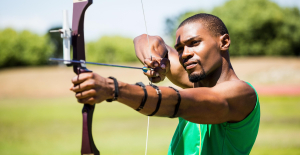Scary is the largest Predator in Central Europe is not just. Rather, it comes across as a cozy type, if it is dozing on the beach – even in the middle of the Winter. Against cold North winds it has a four inch thick coat of bacon. The insulating layer keeps you warm even when you work in depending on the Season, cool or cold sea. The Predator activity that takes place there. Cod and other fish are the victims, every day for five to ten kilograms of them or other inhabitants of the sea – Hiking usually in the stomach of a full-grown grey seal. After the catch the up to 350 kg animals to swim back to the beach. Digestion sleep is called for. You enjoy now and more off the German coast. And mostly unmolested.
the last of The grey seal Vorpommern, was killed in 1920
This was not always so. Even at the beginning of the last century, the Prussian authorities, premiums paid for example, because the fishermen complained that grey seals would make the fishing dispute. In 1927, the hunting was banned then. However, the last grey seal was hunted to the coast of Western Pomerania in 1920. In other regions decimated by hunters, the grey seal.
Factually, the fishermen had, with her accusation only half-right. "As the grey seals and common seals were gone in the 1920s by the German coasts, and have not recovered, the fish stocks," says Michael Dähne, as a zoologist at the German marine Museum in Stralsund, for marine mammals responsible. In the Bodden waters of Mecklenburg-Vorpommern cone catch seals usually just a percent of the floating fish, while sea birds swallow five times the amount. And eight per cent get anglers out of the water. Professional fishermen catch with 22 percent for the lion's share.
There, where they still existed, were continued in the second half of the twentieth century, then contaminants such as the insecticide DDT and the plasticizer PCB of the cone to seal. The many coasts of the Northern Atlantic live, the species was decimated a second Time massively. In 1980, thousands of grey seals living in 1900 in the whole of the Baltic sea were around a hundred, just 2500 animals left.
British immigrants to North German coast
Since that time, the species is strictly protected and recovered. Because in the UK a relatively large number of grey seals have survived, to reach the large predators of the German North sea coast. In 1983, a grey seal was probably the first Baby in the Wadden sea to the world. In 1993, the next milestone is reached: for the returnees, the first birth on the dune of the island of Helgoland.
"Today, around 6,000 grey seals between the Netherlands and Denmark on the North sea coast, and are protected in Germany by the Wadden sea national Park back to life," says Hans-Ulrich Rösner, head in Husum, Germany the Wadden sea office of the conservation organisation WWF. Alone on the dune of Helgoland, more than 400 small seals were born in the Winter of 2018/19, already the light of the world. Further moorings on sand banks in the case of the East Frisian island of Juist off the North-Frisian island of Amrum. "For the nature of this return, the largest predator in Central Europe is a great success," says Rösner.
In the Baltic sea and other sub-species of the cone lives of seals. Your Situation is different from that of the kinship in the North sea, where the stocks of approximately 30 000 animals have recovered. The German Baltic sea waters were the marine mammals, but long on the left. In 2004, the first cone appeared seals in the shallow waters between the island of Rügen and Greifswald. Today, some live around the island of Rügen, as well as some loner in front of the other coasts. Their number is however estimated to be not much more than 100. And continue the success they have planted so far at the German Baltic sea beaches.
The "Big Stubber" is too small
Perhaps because of the once-popular rest has disappeared almost completely. Those "Big Stubber" was Bodden is an island in the Bay of Greifswald, the flat of the Baltic sea between the Hanseatic city and the island of Rügen. He is already documented from the middle ages as a place where the animals were kept in their digestion, sleep,. But the island was getting smaller and smaller, because people from there were boulders as a building material to the island of Rügen and on the mainland. As in the 19th century. Century the Large Stubber also had to serve as a gravel pit for road construction in Greifswald, on the island. Since about 1950, he is history. Only at low water, a sand Bank with the last three boulders appear there today. Since gray seals have to lift the grid, but only its head out of the water, fit to be a missing island in the 21st century. Century as a resting place.
Only their young are no longer able to bring the females there as before. The weight of about ten kilograms heavy to carry babies when they were born with a white lanugo release-coat. It keeps them well warm, but not waterproof. So the females are looking in late Winter, a gravel beach as a nursery. Sometimes it's also a stable and large ice floe. Beaches there are on the island of Rügen and on the mainland, although enough of it. They are usually taken from other mammals whose coats do not consist of fat, but rather made of Polyester and viscose, in hardware. And since the Baltic sea cone, the memory of the Almost-extinction seems to be over the generations is not lost, looking expectant seals mother Seals prefer a calmer coast that you can find for example in Sweden or Denmark.
fish places with the Beard
The hundred miles there are only a days. With 15 kilometres per hour, you can be through the Baltic sea. In just three weeks, the mothers your feet soon the young with your extreme fat of milk from ten to 40 kilograms in weight. "A 150 kg heavy, healthy females losing weight during these three weeks on 100 pounds, his four inches thickness of fat layer shrinks to a centimeter," says Dähne. Then mother and child go their separate ways. The females mate already four weeks after birth, in order to bring eleven months later, the next baby seal.
The Junior has now changed his coat, and goes out into the sea to hunt. With your "beard hair" feel seals even the slightest water turbulence, the fish will throw many meters away in the Swim. So to find the animals for up to 20 minutes long dives, plenty more fish – if necessary, also into the nets of the fishermen. To get there, to the delicious meal, tearing the animals to a network. Fishing and bowling friends are seals.
grey seal offspring on the Baltic sea coast - in March will show whether he can survive
The fan base is large enough. The reason for the joy she had at 8. March 2018: Not far from Cape Arkona on Rügen, a 12.5-kilogram Cub was born. It is the first evidence for cone seal-young on the German Baltic coast for a century. A few days later, the holiday island of Usedom was on the beach another seal infant discovered. Both died shortly after their birth. Nevertheless, the chances are not bad that the great seals have one of the now often deserted pebble beaches on the island of Rügen soon more success. "In this Winter we have Robben, while still no cone births observed," says Henning von Nordheim, head of Department for marine nature conservation of the Federal Agency for nature conservation on Vilm island near Rügen in Northern Germany, "but in the past year, the first offspring came only in March."

 United States: divided on the question of presidential immunity, the Supreme Court offers respite to Trump
United States: divided on the question of presidential immunity, the Supreme Court offers respite to Trump Maurizio Molinari: “the Scurati affair, a European injury”
Maurizio Molinari: “the Scurati affair, a European injury” Hamas-Israel war: US begins construction of pier in Gaza
Hamas-Israel war: US begins construction of pier in Gaza Israel prepares to attack Rafah
Israel prepares to attack Rafah Spain is the country in the European Union with the most overqualified workers for their jobs
Spain is the country in the European Union with the most overqualified workers for their jobs Parvovirus alert, the “fifth disease” of children which has already caused the death of five babies in 2024
Parvovirus alert, the “fifth disease” of children which has already caused the death of five babies in 2024 Colorectal cancer: what to watch out for in those under 50
Colorectal cancer: what to watch out for in those under 50 H5N1 virus: traces detected in pasteurized milk in the United States
H5N1 virus: traces detected in pasteurized milk in the United States Private clinics announce a strike with “total suspension” of their activities, including emergencies, from June 3 to 5
Private clinics announce a strike with “total suspension” of their activities, including emergencies, from June 3 to 5 The Lagardère group wants to accentuate “synergies” with Vivendi, its new owner
The Lagardère group wants to accentuate “synergies” with Vivendi, its new owner The iconic tennis video game “Top Spin” returns after 13 years of absence
The iconic tennis video game “Top Spin” returns after 13 years of absence Three Stellantis automobile factories shut down due to supplier strike
Three Stellantis automobile factories shut down due to supplier strike A pre-Roman necropolis discovered in Italy during archaeological excavations
A pre-Roman necropolis discovered in Italy during archaeological excavations Searches in Guadeloupe for an investigation into the memorial dedicated to the history of slavery
Searches in Guadeloupe for an investigation into the memorial dedicated to the history of slavery Aya Nakamura in Olympic form a few hours before the Flames ceremony
Aya Nakamura in Olympic form a few hours before the Flames ceremony Psychiatrist Raphaël Gaillard elected to the French Academy
Psychiatrist Raphaël Gaillard elected to the French Academy Skoda Kodiaq 2024: a 'beast' plug-in hybrid SUV
Skoda Kodiaq 2024: a 'beast' plug-in hybrid SUV Tesla launches a new Model Y with 600 km of autonomy at a "more accessible price"
Tesla launches a new Model Y with 600 km of autonomy at a "more accessible price" The 10 best-selling cars in March 2024 in Spain: sales fall due to Easter
The 10 best-selling cars in March 2024 in Spain: sales fall due to Easter A private jet company buys more than 100 flying cars
A private jet company buys more than 100 flying cars This is how housing prices have changed in Spain in the last decade
This is how housing prices have changed in Spain in the last decade The home mortgage firm drops 10% in January and interest soars to 3.46%
The home mortgage firm drops 10% in January and interest soars to 3.46% The jewel of the Rocío de Nagüeles urbanization: a dream villa in Marbella
The jewel of the Rocío de Nagüeles urbanization: a dream villa in Marbella Rental prices grow by 7.3% in February: where does it go up and where does it go down?
Rental prices grow by 7.3% in February: where does it go up and where does it go down? Even on a mission for NATO, the Charles-de-Gaulle remains under French control, Lecornu responds to Mélenchon
Even on a mission for NATO, the Charles-de-Gaulle remains under French control, Lecornu responds to Mélenchon “Deadly Europe”, “economic decline”, immigration… What to remember from Emmanuel Macron’s speech at the Sorbonne
“Deadly Europe”, “economic decline”, immigration… What to remember from Emmanuel Macron’s speech at the Sorbonne Sale of Biogaran: The Republicans write to Emmanuel Macron
Sale of Biogaran: The Republicans write to Emmanuel Macron Europeans: “All those who claim that we don’t need Europe are liars”, criticizes Bayrou
Europeans: “All those who claim that we don’t need Europe are liars”, criticizes Bayrou These French cities that will boycott the World Cup in Qatar
These French cities that will boycott the World Cup in Qatar Archery: everything you need to know about the sport
Archery: everything you need to know about the sport Handball: “We collapsed”, regrets Nikola Karabatic after PSG-Barcelona
Handball: “We collapsed”, regrets Nikola Karabatic after PSG-Barcelona Tennis: smash, drop shot, slide... Nadal's best points for his return to Madrid (video)
Tennis: smash, drop shot, slide... Nadal's best points for his return to Madrid (video) Pro D2: Biarritz wins a significant success in Agen and takes another step towards maintaining
Pro D2: Biarritz wins a significant success in Agen and takes another step towards maintaining


















